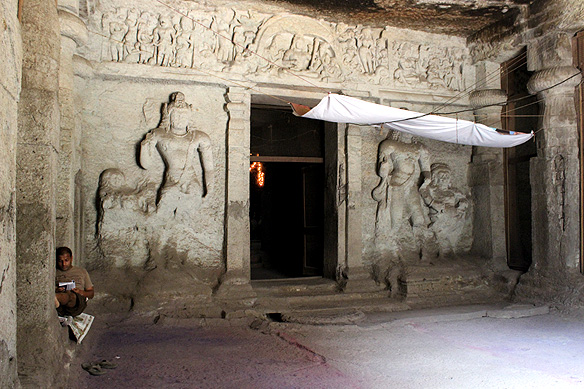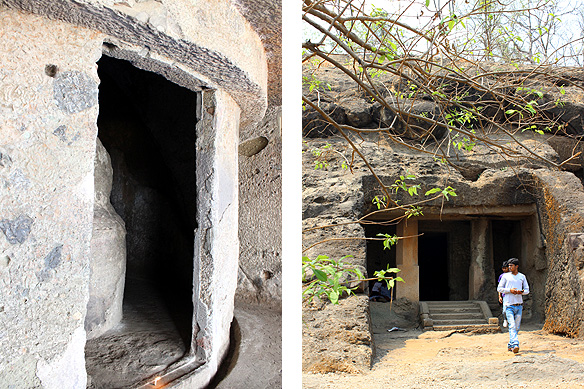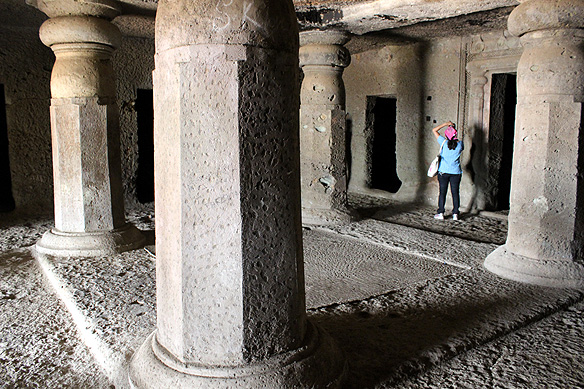
“Let’s explore the rock-cut cave temples of Mumbai this Sunday,” a friend suggests excitedly.
“Caves? I have been to Elephanta and Kanheri. Even written about them! Read my post. 🙂 ”
“Hey, there are more, a lot more in the city itself.”
More? I am confused. Where can there possibly be caves in Mumbai. The city is packed with concrete and people, with little space to walk, least of all millennia old caves to have survived. I am wrong.
Hidden within the crevices of Mumbai’s urban jungle is a pulsating vein of its ancient past. A series of rock-cut temples, connected to each other with tunnels and hidden passageways, lace the city’s basalt bed rock.
During the Gupta period, also referred to as the Golden Age of India (320-550 AD), Buddhist monks were traversing the Western Ghats in Maharashtra, building rock-cut temples with prayer halls, dormitories and votive stupas along trade routes. The rock-cut temples in Mumbai, together with Elephanta and Kanheri, form part of this architectural cluster.
These temples have held within their midst nearly every religion the city has known through its history. Conforming to the religious inclinations of the populace, they have worn the mantle of at times a Buddhist, and at others Christian or Hindu places of worship. Today, prayers and rituals continue in their inner sanctums, even as they morph into meeting yet other societal needs.
While the Mandapeshwar caves double up as a cricket field for slum dwellers, Jogeshwari serves as a quiet peaceful space for post-graduate students living in the surrounds to study. Mahakali in the meantime is the playground for children and budding romances, as well as a meeting place for evangelizing activities of political parties.
The Mandapeshwar Caves in Mount Poinsur has the most fascinating history. It started off as a Hindu Shiva temple, got converted into a church by early Christian missionaries and then reverted back into a temple post the Maratha invasion in the 18th Century. The caves are topped by a 16th Century chapel, now in ruins, and the Immaculate Conception church and graveyard from the Portuguese Christian period.
Mandapeshwar literally means Mandap Pe Eshwar, hall of painting of the lord, which is what the cave started off as. Legend claims that the monks built the caves and then hired Persians travelling through the region to paint scenes from Shiva’s life on its walls. But time has taken its toll. The paintings have washed away; the late Gupta Empire styled sculptures of Shiva defaced.
The large mandapa and inner sanctuary, despite this, still see a continuous stream of devotees come in and carry out rituals, unchanged through the centuries.

Bas-relief panel of Shiva as Nataraja surrounded by celestial beings in the Mandapeshwar Caves, a hindu rock-cut temple built by Buddhist monks

Left: The cave temples were converted into a church by the Portuguese missionaries; Right and below: And later back to a Shiva temple …


… its journey full circle
The Jogeshwari Caves, my next cave-hopping stop, belongs to the same period (520-550 AD) as Mandapeshwar. These caves are the oldest major Hindu cave temples in India and the largest in terms of length (300 feet X 200 feet). They are also completely encroached by slums; sewage and waste seep into the basalt walls.
A flight of stairs lead down into a huge, dark hall enveloped in colossal pillars and an idol of goddess Jogeshwari, a kuladevi or ancestral goddess to many Marathis, in the centre. But that’s not all to it. Wander, and the cavernous cave gives way to a series of smaller ones lined with idols of Dattatreya, Hanuman and Ganesh.
A young man offers to show me around. I follow him, albeit hesitantly, and what do I find? Countless students deep in study for MBA, MTech or CA exams in the ancient temple porches, behind stone pillars, and on the steps. A few introductions later, I am regaled with details about the cave’s architecture and carvings, and their own personal dreams, both seeming to flow seamlessly as one whole.

The oldest, and also the largest, Hindu rock-cut cave temple in India—Jogeshwari Caves

An age-old priest with ancient traditions in a millennia-old temple

Stories in stone …

Dvarpals on either side of the door opening into the prayer hall at Jogeshwari
My last stop is the Mahakali Caves in Andheri, a site I often pass by but have paid scant attention to. Also known as the Kondivite Caves, it is a Buddhist monastery comprising 19 cave temples built between the 2nd to 6th Century AD. Most of the caves are viharas or cells for monks, bare and undecorated.
Cave No. 9 is the jewel in the precinct. The largest and one of the oldest caves in the monastery, it is a chaitya or prayer hall with a shrine and stupa unusual in design; both are enclosed in an 8-inch circular wall with a doorway and latticed windows. The right window has a two-line Pali inscription above it which reads, “Gift of a vihar, with his brother by Pittimba a Brahman of the Gotamas gotra and inhabitant of Pachi Kama.”
The adjacent cave wall is carved with seven depictions of Buddha and figures from Buddhist mythology. I get goose bumps just looking at the classical figures and stylized lines characteristic of Gupta period sculpture, 1,500 years on.

Cave No. 9, chaitya: Carved panel of Buddha with attendants and other figures

The stupa, enclosed in a wall in the chaitya; Right: A series of 15 caves dating to the 2nd Century line the south-east side, the four caves in the north-west are from the 4th to 5th Century

A charming engraving of a stupa on the walls of one of the later caves. My new friends happy to pose for me

Cave No. 14
So dear reader, there is much more to Mumbai than what one expects, at the most unexpected turns and most blatantly obvious roads. Now you know why I keep falling in love with this city, time and again. 🙂
Travel tips:
- The three caves are open to the public and do not have any entry charges.
- They can all be explored in one morning. Leave early to escape Mumbai’s harsh sun.
- Try and combine a visit to the caves at Mandapeshwar with the Franciscan 17th Century Marian Sacromonte above it on Mount Poinsur. You will not be disappointed.
- The best way to commute between the three caves is by auto rickshaw which are readily available.
- The Archaeological Survey of India looks after the caves. This has helped to keep encroachment at bay. There are, unfortunately, no publicity or information materials available. Talk to the locals instead. They have far more interesting stories to share than a printed sheet of paper could ever contain.

Wow, this is simply amazing, imagine have these ancient caves right behind your backyard!
LikeLike
Yup, literally backyard! It is pretty incredible. Another place for you to explore when you visit the city again. 🙂
LikeLiked by 1 person
beautiful Rama… thanks for bringing out the beauty of our city 🙂
cheers, Archana – http://www.drishti.co
LikeLike
Thank you Archana. This city never ceases to amaze me with its countless nuances.
LikeLike
Wow, a beautiful find there. Loved this post 🙂
LikeLike
Hey, thanks Jatin. 🙂
LikeLiked by 1 person
I have lived in Mumbai all my life & am yet to visit some of these places. I didnt even know about the caves in Jogeshwari! Are these places open to public (Mahakali & Mandapeshwar)? Enjoyed reading & viewing the pictures. will surely plan a trip soon.. Thanks!
LikeLike
Hello Isra, glad you enjoyed the post. 🙂 Yes, all three caves are open to the public free of charge. Whilst at Mandapeshwar, do combine it with a walk up to the Marian Sacromonte at Mount Poinsur (it is above the caves) if you have not been there already. It is equally lovely, in a different way. You could read about it here: https://returnoftheprodigal.wordpress.com/2015/04/12/mount-poinsur/
LikeLiked by 1 person
It is wonderful to discover these stories sculpted in stone. I think it’s a wonderful way to explore the city. It’s such a pity that these sites are not publicised.
LikeLike
Yup. And that’s where I hope my blog can contribute in some small way—creating awareness of all the wonderful sites and experiences in India which are right on our doorstep. 🙂
LikeLike
Pingback: mumbai’s csmvs sculpture gallery: where stones speak of art and god | rama arya's blog
Reblogged this on Die Goldene Landschaft.
LikeLiked by 1 person
Thank you for the reblog. Appreciated.
LikeLike